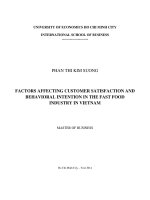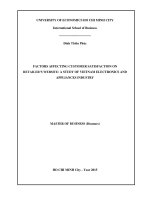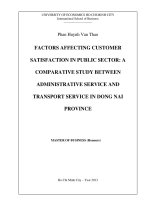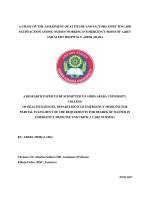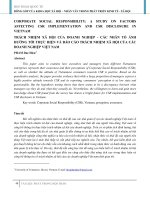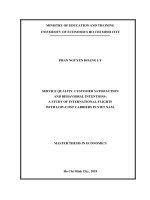Factors affecting customer satisfaction and behavioral intention in the fast food industry in vietnam
Bạn đang xem bản rút gọn của tài liệu. Xem và tải ngay bản đầy đủ của tài liệu tại đây (1.25 MB, 59 trang )
UNIVERSITY OF ECONOMICS HO CHI MINH CITY
INTERNATIONAL SCHOOL OF BUSINESS
-----------------------
PHAN THI KIM SUONG
FACTORS AFFECTING CUSTOMER SATISFACTION AND
BEHAVIORAL INTENTION IN THE FAST FOOD
INDUSTRY IN VIETNAM
MASTER OF BUSINESS
Ho Chi Minh City – Year 2014
UNIVERSITY OF ECONOMICS HO CHI MINH CITY
INTERNATIONAL SCHOOL OF BUSINESS
-----------------------
PHAN THI KIM SUONG
FACTORS AFFECTING CUSTOMER SATISFACTION AND
BEHAVIORAL INTENTION IN THE FAST FOOD
INDUSTRY IN VIETNAM
ID: 22120070
SUPERVISORS: PROF. NGUYEN DONG PHONG
DR. NGUYEN PHONG NGUYEN
Ho Chi Minh City – Year 2014
Table of Contents
Chapter 1: Introduction................................................................................................................
1.1: Research background .......................................................................................................... 1
1.2: Research problem ............................................................................................................... 4
1.3: Research objectives............................................................................................................. 5
1.4: Research scope .................................................................................................................... 6
1.5: The structure of the proposal .............................................................................................. 6
Chapter 2: Literature review and hypothesis .............................................................................
2.1: Service quality .................................................................................................................... 8
2.2: Food quality ...................................................................................................................... 10
2.3: Hedonic value ................................................................................................................... 11
2.4: Utilitarian value ................................................................................................................ 12
2.5: Customer satisfaction ........................................................................................................ 12
2.6: Behavioral purchase intention .......................................................................................... 13
2.7: Hypothesis development ................................................................................................... 13
2.8: The proposal model .......................................................................................................... 17
Chapter 3: Research Methodology ..............................................................................................
3.1: Research design ................................................................................................................ 18
3.2: Measurement scale ............................................................................................................ 19
3.3: Data collection .................................................................................................................. 21
3.4: Data analysis method ........................................................................................................ 23
Chapter 4: Data analysis and result ............................................................................................
4.1: Description statistic........................................................................................................... 24
4.2: The reliability test – Cronbach’s alpha ............................................................................. 25
4.3: Exploratory factor analysis ............................................................................................... 31
4.4: Confirmatory factor analysis ............................................................................................ 36
4.5: The structural equation modelling .................................................................................... 41
4.6: Bootstrap ........................................................................................................................... 43
Chapter 5: Conclusion, implication and limitation ....................................................................
5.1: Conclusion ........................................................................................................................ 45
5.2: Managerial implication ..................................................................................................... 46
5.3: Limitation .......................................................................................................................... 48
References .................................................................................................................................. 49
Appendix .................................................................................................................................... 53
ABSTRACT
Fast food industry market is a one of potential market in Vietnam with many famous
brand join and expand such as KFC, Lotteria, Jolibee, Mc Donalt, Pizza Hut … More and
more players mean more and more competitor. How to attract more and more customer is the
focus of all players. The study will find out four key factors effect to customer satisfaction is
service quality, food quality, hedonic value, and utilitarian value. The research tests the factors
the relationship between customer satisfaction and behavioral purchase intention.
CHAPTER 1
INTRODUCTION
This chapter provides the general pictures of this study. This study has two objectives:
first, to identify factors affecting customer satisfaction in the fast food industry in Vietnam,
secondly, to test the effect of these factors on customer satisfaction and purchasing intention
behavior. The research background section presents the overall situation of the fast food
industry in Vietnam. Then the research problem is identified and research objective is
determined, which in turns provide a ground for developing the research methodology and
setting scope of this study
1.1 RESEARCH BACKGROUND
The fast food restaurant caters to people who want to buy food that is fresh and served
quickly. In American, most fast food restaurant have drive-thru service that allows people to
get their food without getting out of their cars. The fast food industry started its first step to
1
growth when McDonalds became popular in the late 1940s and early 1950s (What is the Fast
food industry, n.d.). Fast food restaurants design menus focus on being able to cook the food
quickly and easily. They strive for absolute consistency so customers can be assured that
everything they buy will always taste the same regardless which location they visit.
McDonald's has outlets in 126 countries on six continents and operates over 31,000
restaurants worldwide. On January 31, 1990, McDonald's opened a restaurant in Moscow and
broke opening-day records for customers served. The Moscow restaurant is the busiest in the
world. The largest McDonald's in the world, with 25,000 feet of play tubes, an arcade and play
center, is located in Orlando, Florida, USA.
There are numerous other fast food restaurants located all over the world. Burger King
has more than 11,100 restaurants in more than 65 countries. KFC is located in 25 countries.
Subway is one of the fastest growing franchises in the world with approximately 39,129
restaurants in 90 countries as of May 2009, the first non-US location opening in December
1984 in Bahrain. Wienerwald has spread from Germany into Asia and Africa. Pizza Hut is
located in 97 countries, with 100 locations in China. Taco Bell has 278 restaurants located in 14
countries besides the United States.
In Thailand, chain restaurants are considered to cater for customer who is willing to pay
more for better service. In fact, chain restaurants in Thailand often offer a nicer décor, a cleaner
environment or even a better service compared with those in the United States (Polyorate &
Sophonsiri, 2010). Since the chain restaurant commonly uses service quality to distinguish
itself from the competitors, providing a high level of service quality has become an ultimate
goal for many chain restaurants. (Polyorat & Sophonsiri, 2010)
The fast food industry is a large and diverse industry with plenty of opportunities. Fast
food franchises are responding with new offerings, pricing and strategies to lure consumers
back in. Consumers want new ways to have a fast and healthy food, so the fast food industry
2
continues to evolve when the economy strengthens, and the fast food franchise profitability is
expected to be promising.
Tenth biggest fast food in the world is Subway, Mc Donalds, Starbuck, KFC, Burger
King, Pizza Hut, Dunkin’s Donut, Domino Pizza, Dairy Queen, Papa John’s. Most of them join
Vietnam market.
Foods in fast food restaurants are standardized and customer gets familiar meals in every
location of one chain. For example, customers can enjoy the same taste of pizza in Pizza Hut
restaurants in Ho Chi Minh City or Pizza Hut branches in Hanoi. Fast food restaurant usually
(as KFC, Lotteria ...) uses the same format for all restaurants in all regions.
With over 65% of 90 million people in Vietnam is less than 35 years old, the fast food
industry in Vietnam has an annual grow rate of 26% during the economic downturn while other
industries experienced a decline in terms of sales. According to data provided by Business
Monitor International in 2011, Vietnam was ranked 8th in the Asia Pacific region in terms of
food and beverage business environment (Vietnam fast food market see bright future, 2013)
Vietnam fast food market is rising with many giant names such as Lotteria with 162
restaurants, KFC with 130 restaurants and Jollibee with 30 restaurants. Some more chain which
has joined the Vietnam fast food market in the recent years includes Pizza Hut, Burger King,
Popeyes and McDonald’s. It could be seen that young people in Vietnam will help to develop
the fast food industry. According to foreign players, Vietnam is an emerging market for fastfood development compared with other markets in Asia (Hoang Phi, 2013).
Fast food industry in Vietnam get a big boom in 2014 when KFC gains 180 stores in
after 17 years join the market while Lotteria has 187 stores in Vietnam after 16 years. Pizza
Hut opens the 50th restaurant in Vietnam in 2014. IPP group is owner of Burger King, Domino
and Popeyes with total 41 stores in nationwide.
3
This can be concluded that while Vietnam is potential market for fast food industry, this
is the time for player to understand clearly the key factors effect to customers and how to build
customer loyalty to be success in Vietnam market to choose the best way to make customer
satisfaction.
1.2 RESEARCH PROBLEM
With the high rate of young adult in Vietnam, 65% as mention above, the fast food
industry has experienced a fast growing stage. Beside the chance, there are threats of new
entrants to the industry which increase the level of industry competition and thus each industry
players have to find ways to enhance their competitive advance to stay away from the fierce
competition. To survive, fast food restaurant needs to follow their market-oriented strategy that
focuses on enhancing customer satisfaction and purchasing intention. Fast food restaurants
have to learn and change their menus to enhance customer satisfaction.
These stores of Jollibee, numerous corners in Ho Chi Minh City are increasingly
frequented by young people, especially children who will insist on having easy-going meals
treated by their fond parents. To better cater to these customers, many stores have managed to
localize ingredients as a way to attract more patrons.
According to Truong Ham Liem, the marketing manager of Lotteria Vietnam, “Lotteria
focuses on developing products and services continuously to serve customers, especially fastfood rice”. “We mainly target local teenagers, but it is a fact that in past years our main
customers were young people and white-collar workers.” Liem says the fast-food business is
thriving in Vietnam regardless of the global economic crisis, adding rice now is an important
ingredient in the menu to attract locals. Also, Demis Flore, vice president of Jollibee says that
the most popular choice at Jollibee’s is rice with chicken, which brings 60% of Jollibee’s total
turnover (When fast food is localized, 2009)
4
The two biggest fast chains in Vietnam set a plan to open more and more restaurants in
Vietnam. KFC own 116 restaurant at the end of 2012 and plan to have 200 restaurants at the
end of 2015. In 2011, Lotteria had 100 restaurants in Vietnam and will reach 200 stores in
2016. In the recent years, more and more foreigner fast food player join Vietnam market and
expand quickly as Pizza Hut, Jollibee, Burger King, Domino, Popeyes, Mc Donalt’s, Subway
…Burger King invests 1 store/160,000 people (Nguyên Hưng, 2012)
“A report in 2012 by W&S Group, an online market research group in the Asia Pacific
region, with 272 people aged above 16, showed that young people come to fast-food restaurant
at least once every three months.” (Vietnam fast-food market sees bright future, 2013)
With many famous players of fast food industry in Vietnam, players have to learn how
to survive and develop in Vietnam. As Vietnam is a potential and challenge market, fast food
restaurants in Vietnam have to understand the key factors affecting customer satisfaction and
how to build customer loyalty, and how to improve customer purchasing intention and
recommending to others because word of mouth are very effective in Vietnam.
1.3 RESEARCH OBJECTIVES
There are two objectives of the study:
1.
Identifying factors affecting customer satisfaction in the fast food
restaurant industry in Vietnam.
2.
The relationship between customer satisfaction and customer purchase
intention behavior in the fast food restaurant industry in Vietnam.
5
1.4 RESEARCH SCOPE
This study focuses on fast food consumers living in Ho Chi Minh City, the largest
economic center of Viet Nam with the population of ten million people. This city gathers
people from many provinces, and cities in Vietnam. Most player choose
Firstly, the author builds model and questionnaire based on previous researches.
Secondly, the author collects data by some ways. Thirdly, the researcher uses Cronbatch’s
alpha to test scales availability and factors analysis to determine which of fairly large set of
items are most answered most similar by the respondents. Then, the researcher uses CFA to test
the relationship of six construct of factor service quality. Finally, the author uses SEM to test
the relationship between four factors: service quality, food quality, hedonic value, utilitarian
value with customer satisfaction and between customer satisfaction and behavioral purchase
intention.
1.5 THE STRUCTURE OF THE STUDY
The study includes five chapters as following:
Chapter 1: Introduction
The chapter includes the following contents: the background of the research, research
problems, research objectives, research scopes, and the research structure.
Chapter 2: Literature review and hypothesis
The chapter presents the fundamental theories and definition of each factors, construct,
proposed hypothesis and theoretical modeling. In this chapter, the author presents the
conceptual model of the study.
Chapter 3: research methodology
The author presents the research design, research methodology, and the process of
conducting the research in this chapter.
6
Chapter 4: Data analysis and result
The characteristics of collected samples, method to collect data, and the result of the
research analysis are presents in the chapter. Based on the result, the author tests the
hypothesis.
Chapter 5: Conclusion, implications and limitations
This chapter performs the main result of the research, the contribution of the study in
management theory and practice as well as the limitations of the study for future research
direction.
7
CHAPTER 2
LITERATURE REVIEW AND HYPOTHESIS
The chapter identifies key factors effect to customer satisfaction and customer purchase
behavior intention. There are many research to survey and find out which factors influence to
customer satisfaction and build behavioral purchase intention in many market as in Thailand,
Chinese … The studies indicate factors effect to customer satisfaction in fast food restaurant.
Qin and Prybotuk (2010) defines service quality, food quality, perceived value are key factors
affect to customer satisfaction. Namkung and Jang (2007) tested the effect of food quality in
customer satisfaction. Ryu (2010) proved that hedonic value and utilitarian value effect to
customer satisfaction.
Quality is known as the performance of product or service (Churchill & Surprenant,
1982; Johnson & Formell, 1991). In fast food industry we will concern on food quality and
service quality.
2.1 SERVICE QUALITY
The importance of service quality is substantially addressed in the fast food
management literature. Superior service leads to satisfied and loyal customers whose continued
patronage is essential to the success of fast food restaurant. On the otherwise, poor service
quality increase customer dissatisfaction and the likelihood that customer dine at a competitor’s
fast food restaurant and become an active champion in persuading others to go elsewhere
(Gilbert et al., 2004). Hence, it is crucial for supervisor, management team to understand how
customers perceive the service they provide, and what components might determine the nature
of the perceived service quality in fast food restaurant.
8
Service quality is “the delivery of excellent or superior service relative to customer
expectation” (Zeithaml and Bitner 1996, p.117). There are two dimensions of service quality:
technical and functional. Technical quality relates to meal provision and functional quality
relates to how to provide a meal (Polyorat and Sophonsiri, 2010). In restaurant industry, there
are many researcher test SERVQUAL instrument (Parasurama et al, 1985). The dimensions of
SERVQUAL include reliability, tangibles, responsibility, assurance, and empathy. Berry and
Parasuraman (1991, p.16) define the dimension as:
1.
Reliability: the ability to perform the promised service dependably and
accurately.
2.
Tangibles: the appearance of physical facilities, equipment, personnel, and
communications materials.
3.
Responsiveness: the willingness to help customers and to provide prompt
service.
4.
Assurance: the knowledge and courtesy of employees and their ability to
convey trust and confidence.
5.
Empathy: the provision of caring, individualized attention to customers.
SERVQUAL has been widely used by service quality researchers for some considerable
period of time. The five components of the model become the most popular strategy for
competing in a service environment, especially where a high level of competition is evident
(Albaba, 2006). Consequently, the introduction of SERVQUAL changes the face of service
industry. Since the items defines in the SERVQUAL instrument are thought to be too general
(Akbaba, 2006).
SERVQUAL scales measures service quality by the degree of discrepancy between
customer’s normative expectation for the service and their perceptions of the provider’s actual
performances (Parasuraman et al., 1985, 1988). Five dimensions are unsheathed as the main
attributes of service quality across a variety of services.
9
Beside the five components, the way of employee in restaurant faced with their failure of
their mistake is very important. How employer explain, apologize, solve mistake with make
customer happy or unhappy with the restaurant. Qin and Prybutok (2007) show the necessary
of recovery and put one more dimension in service quality is recovery. Most customers can
accept that service is not flawless and mistakes are tolerated if they believe that the restaurant is
concerned about resolution of the service problem.
Failure itself does not necessarily lead to customer dissatisfaction; however, failure to
handle recoveries effectively can lead to lost customers and negative word of mouth (Heskett et
al.,; McColl et al., 2005). Moreover, the complete resolution of critical service failure can even
provide positive word of mouth endorsements and future repeat patronage (Leong & Kim,
2002).
2.2 FOOD QUALITY
Food quality is viewed related to satisfaction within fast food restaurants (Kivela et al.,
1999; Law et al., 2004, Johns and Howard, 1998). Food quality is a necessary condition to
satisfy the needs and expectation of customers. Suled and Hensley (2004) investigate that food
quality appeared to be the most significant predictor of customer satisfaction although food
quality explain only 17% of repeat – patronage intentions and lump all food attributes into only
one variable, food quality.
Food quality is one of the key constructs in the model for the restaurant experience
because it is developed on the aspect of technical quality. Food quality includes the factors:
presentation, variety, healthy options, taste, freshness, temperature (Namkung and Jang, 2007).
Kivela et al. (1994) indicate many attribute of food quality: presentation, tastiness, menu
item variety, and temperature. Presentation is how attractive the food looked like and decorated
as a tangible cue for customer perception of quality. The presentation of food is the key food
attribute in a modeling dining satisfaction and return patronage (Namkung and Jang, 2007).
10
Menu with many items help customers have many option to meet customers’ demand.
Many proactive restaurants have created and assortment of food and beverage offerings. Menu
item variety is a crucial attribute of food quality in creating dining satisfaction (Kivela et al.,
1999; Raajppot, 2002).
Besides looking for variety menu, customer pays attention in the nutrition of food.
Healthy food has significant effect on customer perceived evaluation of the restaurant
experience (John & Tyas, 1996). Nutritious food is one of the core properties in dining
satisfaction and return patronage. Customer interests in healthy menu items.
Taste of food and the freshness of food show how delicious of the food. Taste of food is
believed to influence restaurant customer satisfaction and future behavior intentions (Kivela.,
1999). Freshness of food has been cited as a crucial intrinsic quality cue of food (John & Tyas,
1996; Kivela et al., 1999)
Temperature effects to flavors, taste, smell, and color of food. Temperature is a sensory
element of food quality (Namkung and Jang, 2007).
2.3 HEDONIC VALUE
Customer seeks a fun, fantasy arousal, sensory stimulation, and enjoyment fast food
restaurant to have meal. Hedonics value is customers’ desires for entertainment such as the
affective response of excitement. It can be defined as “more subjective and personal than its
utilitarian counterpart and resulting more from fun and playfulness than from task completion”
(Babin at al., 1994, p. 646). Hedonic value reflects entertainment and emotional potential.
Hedonic evaluation is more affective than cognitive in nature. Hedonic values are non –
instrumental, experiential, affective and often related to non-tangible retailer/product attributes
(Ryu et al., 2010).
11
The adventurous nature of hedonic value reflects shopping’s entertainment and
emotional potential resulting from the fun and play of the experience versus the achievement of
any pre-specified goal. Hedonic value indicates and assessment of the overall worth of
consumption activity, representing a more comprehensive picture of the value.
2.4 UTILITARIAN VALUE
Utilitarian value is described as “resulting from some type of conscious pursuit of an
intended consequence” (Babin et al., 1994, p. 645). It is evaluated as a traditionally functional,
instrumental, and cognitive in nature (Ryu et al., 2010). It effects fulfillment of instrumental
expectations of consumers in products or services. In the utilitarian view, consumers are
concerned with purchasing products in an efficient and timely manner to achieve their goals
with a minimum of irritation.
Hedonic value and utilitarian value reflect consumers’ evaluations of the consumption
experience. Utilitarian dimension results from work aspects and the hedonic dimension derives
from the fun perspective (Ryu et al., 2010).
Thus, in this study, the author adopts this two dimensional conceptualization of
consumer value.
2.5 CUSTOMER SATISFACTION
Customer satisfaction is an essential indicator of the company performance in past,
current and future. Customer satisfaction is a central concept in marketing because it is crucial
to meeting the needs and wants of customers. It is also as a result of the post-consumption
evaluation of services. Customer satisfaction is how happy is a customer with a product or
service at a certain point of time (Namkung and Jang, 2007). Customer satisfaction refers to
customer’s fulfillment response (Rust and Oliver, 1994). It is defined as an emotional response
12
to an evaluation of interaction experiences (Heung and Ngai, 2008). Hunt (1977) defined
customer satisfaction as “an evaluation rendered that the product experience as at least as good
as it was supposed to be” (p. 459).
A customer satisfies if he or she can get a product or service with the same quality or
higher quality than what he or she expects. Service-encounter and overall satisfaction are two
ways of viewing customer satisfaction (Bitner and Hubbert, 1994). Service-encounter means
customers are satisfied with a specific service encounter and the rest is based on multiple
encounters (Polyrat and Sophonsiri, 2010). Customer satisfaction is and overall judgment
process of perceived discrepancy between prior expectation and actual consumption (Han and
Ryu, 2009)
2.6 BEHAVIORAL PURCHASE INTENTION
Purchase intention can be classified as one of the components of consumer cognitive
behavior on how an individual intends to buy a specific brand or product.
Behavioral intention shows the belief of customers. The signal of customer behavioral is
that customers want to be bonded with a company. Customers say positive things about
company recommend the company or service to others and remain loyal to company (Namkung
and Jang, 2007). The obvious reason to satisfy customers is to acquire repeat business and
positive word of mouth, thereby improving a chance of firm profitability. High level of
satisfaction increases customers purchase intention. Behavioral intentions include visit, revisit,
recommendation, and positive word of mouth intentions.
2.7 HYPOTHESIS DEVELOPMENT
Relationship between service quality and customer satisfaction:
13
Service quality plays an important role in customer satisfaction. Service quality is one
key factor make customer satisfy. The connection between service quality and customer
satisfaction has been well established in the services marketing literature (Antony et al., 2004;
Ladhari, 2009; Sivadas and Baker-Prewitt 2000). Service quality directly and positively
influences in customer satisfaction (Qin and Prybutok, 2009; Polyrat and Sophonsiri, 2010).
Customers in fast food restaurant have many options while more and more brands joined the
market industry. Customers become smarter and compare one with other to choose the best. so,
it is more difficult to make customer satisfy. Customers nowadays focus on service quality.
Service quality includes six constructs: reliability, responsibility, assurance, empathy, recovery
and tangible.
Customer have high expectation in a cleaning, convenience restaurant with well- trained
staff how is the attitude of staff. Based on the researches, the author posits that service quality
is the antecedent of customer satisfaction.
The first research hypothesis is:
H1: Service quality has a positive effect on customer satisfaction.
Relationship between food quality and customer satisfaction:
Food quality is one key element of the overall restaurant experience (Keivela et al.,
1999; Raajpoot, 2002; Sulek & Hensley, 2004). Food quality is viewed related to satisfaction
within fast food restaurant (Namkung and Jang, 2007; Qin and Prybutok, 2010). The results of
these researches show the positive effect of food quality to customer satisfaction. Vietnamese
nowadays care more about the quality of food when choosing a restaurant to enjoy a meal. The
more the incomes of customer increases, the more customers will pay attention on quality,
especially food quality because the food effect to customer’s health. By the way, customers
were attracted by how a food is presented. Customers prefer delicious, fresh, and healthy food.
14
As a result, the second hypothesis is:
H2: Food quality has a positive effect on customer satisfaction.
Relationship between hedonic value and customer satisfaction:
Ryu et al., (2010) showed that the hedonic value influence customer satisfaction.
Hedonic value influence customer satisfaction (Babin et al, 1994). Most of people currently
were high pressure with family; work, school … so they need a place can serve them good
food, good service and good feelings. Fast food restaurants also are the place for customer
cheer happiness to friend or family. Nowadays, many Vietnamese parents choose fast-food
restaurant for their children birthday party. Customers would like to choose a fun, pleasant,
exciting restaurant. The factors offer the satisfaction to customers. Customers do not find a
place to have meal. Customers choose a place to enjoy meal. Therefore, hedonic value is very
important for a fast food restaurant.
The third hypothesis is:
H3: Hedonic value has a positive effect on customer satisfaction
Relationship between utilitarian value and customer satisfaction:
Ryu et al., (2010) showed that the utilitarian value influence customer satisfaction. More
and more customers do not have more time for lunch, dinner. Nowadays, time is very important
for many customers. Customers think carefully on using time and money. The demand of
customers is increasing day by day. They are smart customers. They require many factors for
their pay. To saving time they need a quick service. To enjoy, the need a convenience play. By
the way, they need a restaurant give them economics meal as well. The meal has to value as the
money they pay. Utilitarian is one key factor makes customer happy.
15
The fourth hypothesis is:
H4: Utilitarian value has a positive effect on customer satisfaction
Relationship between customer satisfaction and behavioral purchase intention:
Getty and Thompson (1994) indicated that high level of satisfaction make customer
intention to purchase increase and customer would recommend the product to other. Han and
Ryu (2007) showed that the high level of customer satisfaction is increasing revisit and
recommendation intentions, positive word of mouth. Young people in Vietnam usually have
lunch or dinner in group. Word of mouth is strong effect in marketing strategy. When
customers satisfy with a restaurant, customers usually remember or take address of the
restaurant. They would like to back to the restaurant when they have chance. By the way,
customers would like to share it with their friends, their family. Especially, some customers
will hold some parties their as birthday party, welcome party, farewell party. Customer
satisfaction has a positive effect on behavioral purchase intention.
The firth hypothesis is:
H5: Customer satisfaction has a positive effect on behavioral purchase intention.
16
2.8 THE PROPOSAL MODEL
Based on the review of the previous literature review and hypothesis presented, the author
proposes the conceptual model as below:
Service quality
H1
H2
Food quality
H3
Customer
satisfaction
H5
Behavioral
purchase intention
Hedonic value
H4
Utilitarian value
Figure 1 Conceptual model
Summary:
This chapter mentions about the definition and theoretical background of each concept
in the model. The above literature indicates the factors affect to customer satisfaction and
relationship between customer satisfaction and behavioral purchase intention. There are five
hypotheses in this study.
17
CHAPTER 3
RESEARCH METHODOLOGY
In this chapter, the author mentioned about the ways to find the answer for research
questions. The chapter includes six main contents: research design, research process, research
scale, sample size, data collection procedure and data analysis method.
3.1 RESEARCH DESIGN
The author focused on examining the factors affecting to customer satisfaction and how
customer satisfaction toward behavioral purchase intention in fast food industry in Viet Nam.
The researcher tested the effect of these factors service quality, food quality, hedonic value,
utilitarian value on customer satisfaction and relationship between customer satisfactions with
behavioral purchase intention. Service quality factors included six constructs such as reliability,
responsibility, tangible, recovery, empathy, and assurance. Figure 1 presented for the
conceptual research model of the study. Primary data collected from consumers in Ho Chi
Minh City are used in the research. A questionnaire survey was used as data collection method.
Based on the items and scales of previous research shown in figure 3.2, the researcher
created a questionnaire included two part: the first part is general information the researcher
need from observation as aged, income, sex, career and the second part was include all items
in figure 3.2. The author translated the questionnaire in to Vietnamese for delivering to
respondents.
The author comprised in two phases, a pilot study, and a main survey. In pilot study, the
researcher interviewed directly twenty people in Ho Chi Minh City and got their feedback
about primary questionnaire. Twenty pilot observations were the author’s friends and
colleagues. The researcher got all feedback from twenty observations to find out which words
18
should be change to let observation easy to understand the meaning of the studying and to
answer. The author adjusted the questionnaire to be more suitable to Vietnam market, clearer
and easier to understand. (See appendix 1).
3.2 MEASUREMENT SCALES
Base on the literature, the researcher set up the survey instrument, using scales as
follow:
All the measurement scales used Likert scale from 1 (completely disagree) to 7
(completely agree).
Service quality: Quin and Prybutok (2009) research that service quality includes
6 construct: reliability, tangibles, responsiveness, assurance, empathy, and recovery.
There are five items for the first construct: reliability:
REL1
providing service as promised
REL 2
sympathetic and reassuring
REL3
Dependable
REL4
On-schedule service
REL5
Accurate charge
Tangible is measured by five items:
TAN1
Clean dining area
TAN2
Well-dress employees
TAN3
Using disposable gloves and hair net
TAN4
Seating available
TAN5
Parking available
Responsibility includes four items:
RES1
Telling exact service time
RES2
Employees available to request
19
RES3
Prompt service
RES4
Employees willing to help
Assurance has four following items:
ASS1
Trust employees
ASS2
Feel safe for financial transactions
ASS3
Friendly employees
ASS4
Knowledgeable employees
There are four items to measure empathy:
EMP1
Available of utensil, etc
EMP2
Convenient operating hours
EMP3
Convenient locations
EMP4
Completely package food
Recovery is presented by four following items:
REC1
Employee quickly apology for mistake
REC2
Care about customer complaint
REC3
Skill and ability to deal with complaint
REC4
Employees empower to provide compensation
Food quality is measured by six items according scales of Namkung and Jang (2007)
FQ1
Food presentation is visually attractive
FQ2
The restaurant offers a variety of menu items
FQ3
The restaurant offers healthy options
FQ4
The restaurant serves tasty food
FQ5
The restaurant serves fresh food
FQ6
Food is served at the appropriate temperature
According to Ryu et al. (2010), there are four items to measure hedonic value:
HV1
I ate out at fast a fast food restaurant since I could have good feeling
HV2
Eating out at the fast food restaurant was fun and pleasant
20
HV3
The dining experience at the fast food restaurant was truly a joy
HV4
During the dining experience at the fast food restaurant, I felt the
excitement of searching food
Ryu et al. (2010) are used three times to measure utilitarian value construct:
UV1
Eating out at the fast food restaurant was convenient
UV2
It was waste of money when eating out at the fast food restaurant
UV3
Service at the fast food restaurant was quick
Namkung and Jang (2007) measure customer satisfaction based on two items:
SAS1
I am satisfy with the service in this restaurant
SAS2
I am pleases to have visited the restaurant
Customer satisfaction towards behavioral intentions is measured by three items
borrowed from the scales of Ryu et al. (2010)
BI1
I would like to come back to the restaurant in the future
BI2
I would recommend the restaurant to my friends or others
BI3
I would more frequently visit the restaurant
In totally, the study used 44 items to measure 11 constructs, include 9 independent variables
and 2 dependent variables.
3.3 DATA COLLECTION
According to Hair et al (2010), minimum observation is five times than items. The total
item of the research is 44 so the total observation is more than 220 samples. According to
Tabanik and Fidell (1991), observation should be more than 50 + 8*m (m is total independent
variables). For the research, there are four independent variables so the minimum observation
should be 82. To measure the scales in the study, the author aimed to get 300 answers so the
authors used more than 300 observations to get feedback.
21

